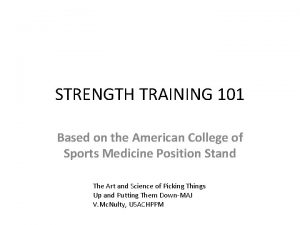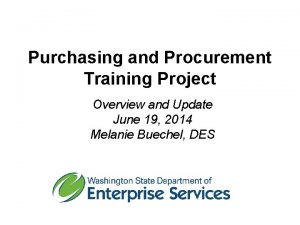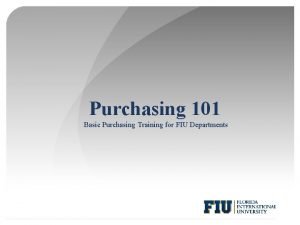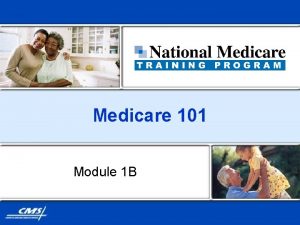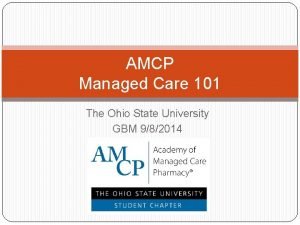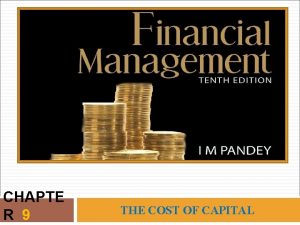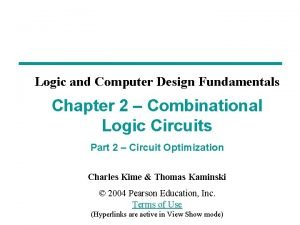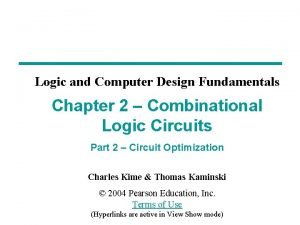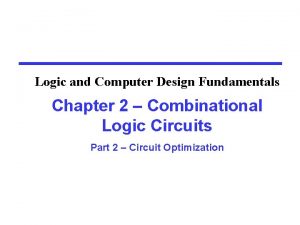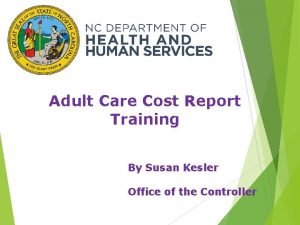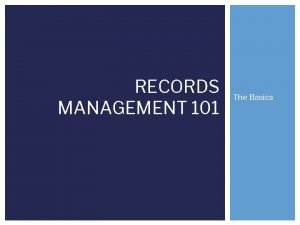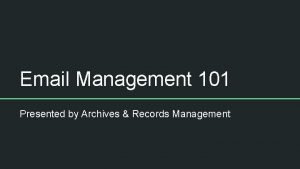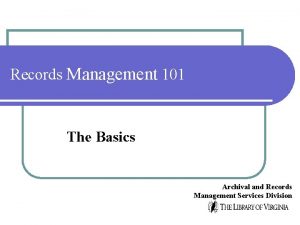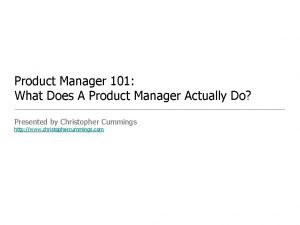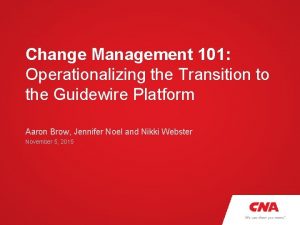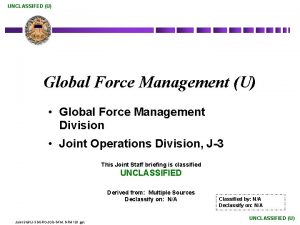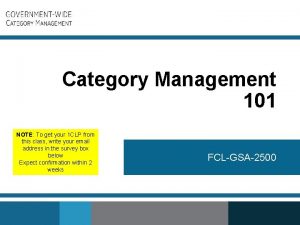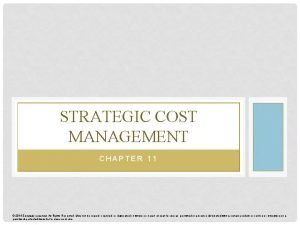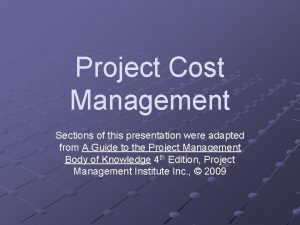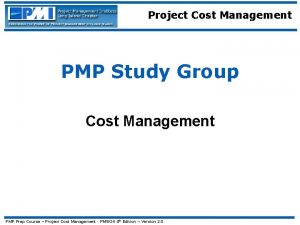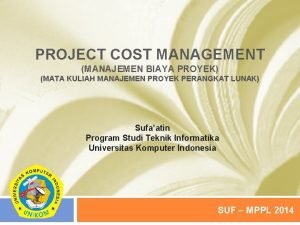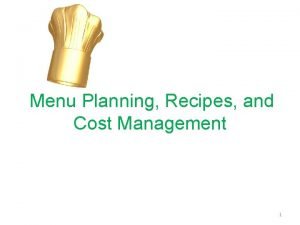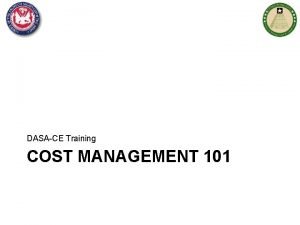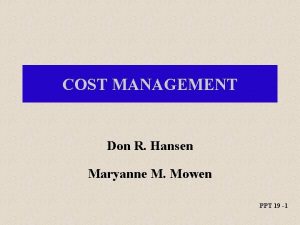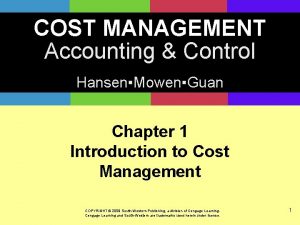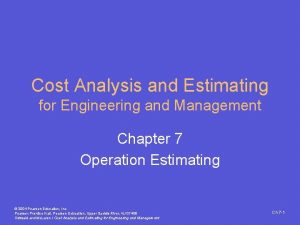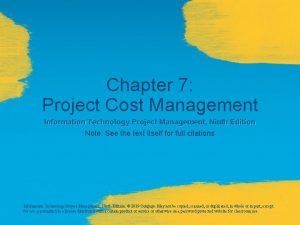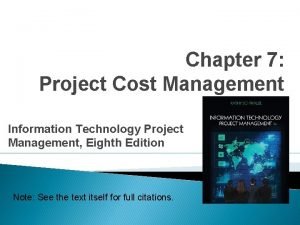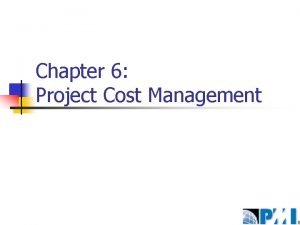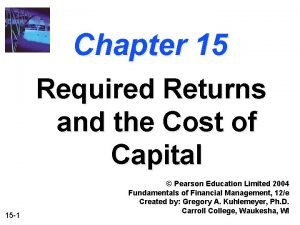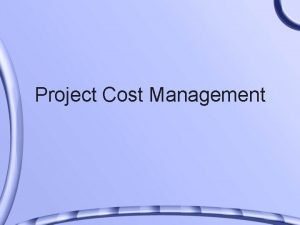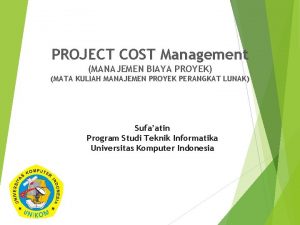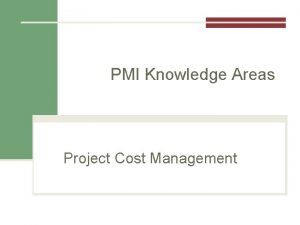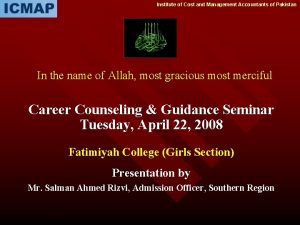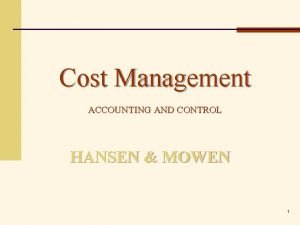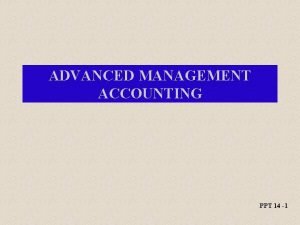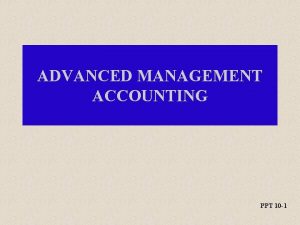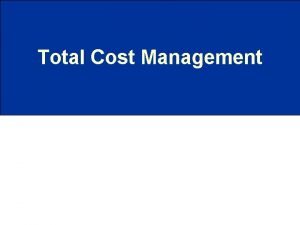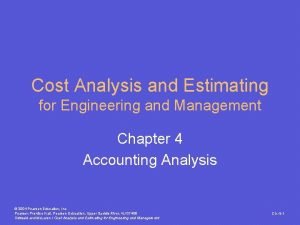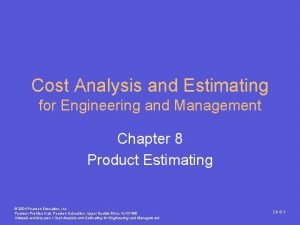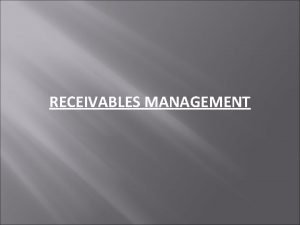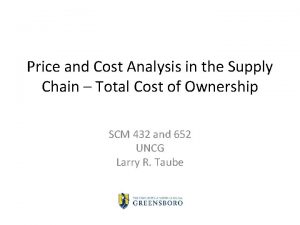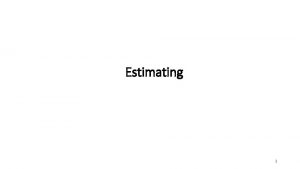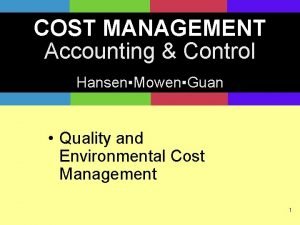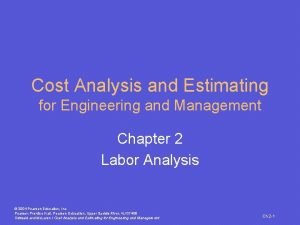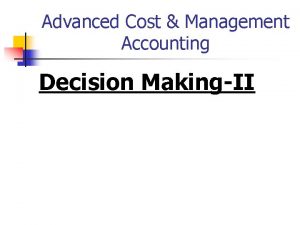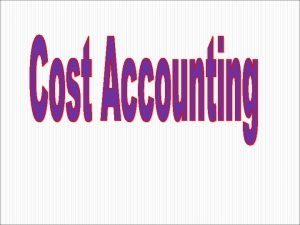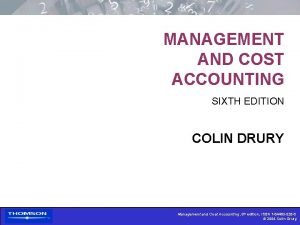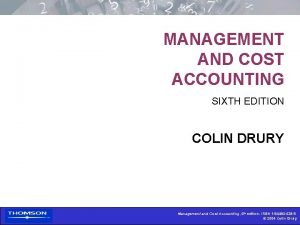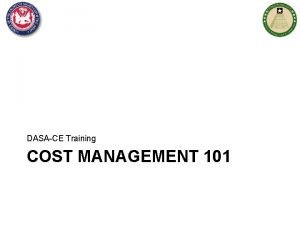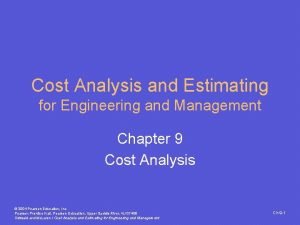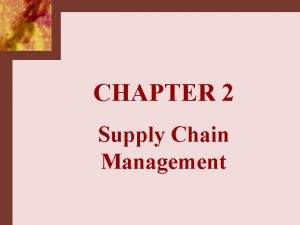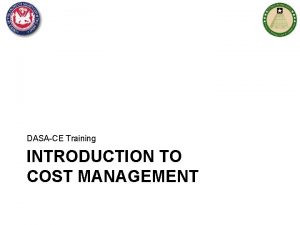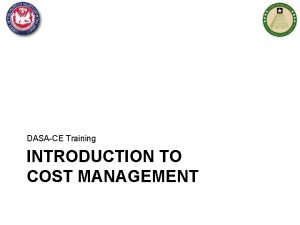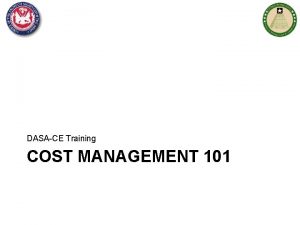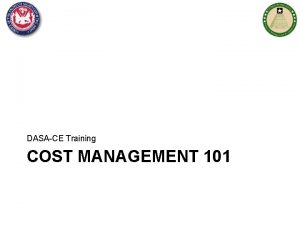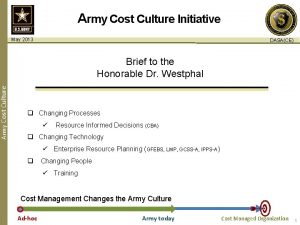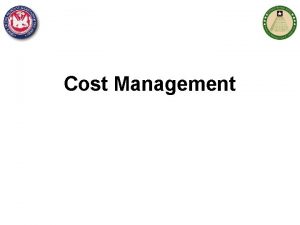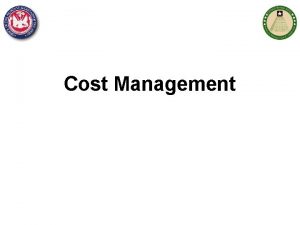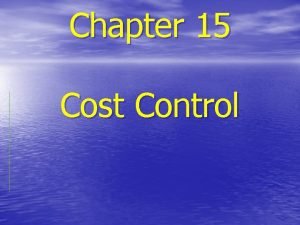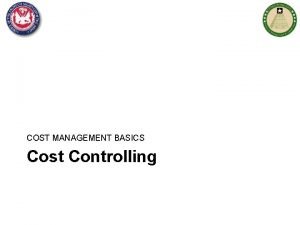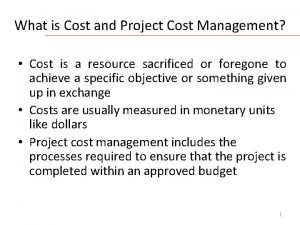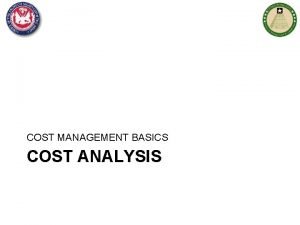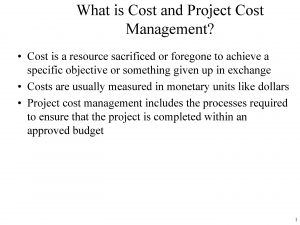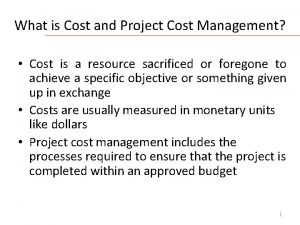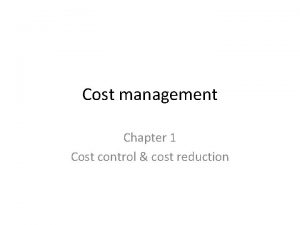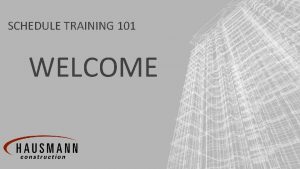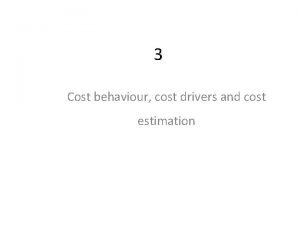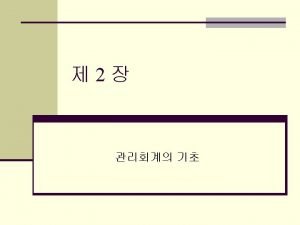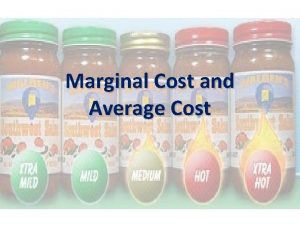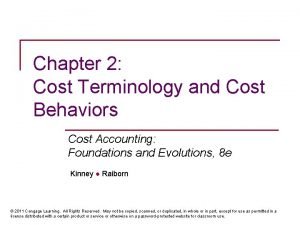DASACE Training COST MANAGEMENT 101 Who are We

























































































- Slides: 89

DASA-CE Training COST MANAGEMENT 101

Who are We? COMMAND SITE Cost SMEs Team DASA-CE Cost Team GFEBS - Deployment - Training -O&S - Site Support Ø COMMAND SITE SMEs: Command Site resources identified in some manner to provide subject matter expertise and information for a GFEBS related effort (e. g. Supervisors, Users, etc. ) Ø COMMAND COST TEAM: Command HQ resources identified to support the deployment of Cost Management functionality within the new applications, e. g. GFEBS, GCSS-A. (Not every command has a specific Cost Team) Ø DASA-CE COST TEAM: A specialty group supporting Army Commands in the transformation to a “Cost Culture” utilizing ERP tools (e. g. GFEBS, GCSS) Provides Cost Management (CM) Training Assists Commands in defining Cost objectives Provides CM Capture Teams to develop CM Master Data with sites and then provided to GFEBS Ø GFEBS: Various teams focusing on specific objectives in order to make the overall program a success 2

DASA-CE Cost Mission Enable the Army in Transitioning to a Cost Culture utilizing ERP applications (e. g. GFEBS, GCSS, etc. ) 1. Define the Cost Model across the Army (HQ Design) • Identify Command Strategic Objectives (e. g. products/services) • Determine methods/mechanisms to determine Full Costs of Objectives 2. Train Cost Concepts (approx. 12 hr Training Session) • Not specific GFEBS training on running cost transactions • Builds a language to transition from legacy to future • Aids field in understanding level of effort to perform Budget Execution vs Cost Management • Focus is on Cost Management terms, processes, structures, reporting, etc. 3

DASA-CE Cost Mission (Continued) Enable the Army in Transitioning to a Cost Culture utilizing ERP applications (e. g. GFEBS, GCSS, etc. ) Cont’d : 3. Support the definition and collection of master data to be loaded for cut-over into GFEBS , etc. (CM Build) • Training and supporting the “Capture Teams” – Command specific teams working in conjunction with the DASA-CE CM team to gather all the data required for the waves • Aid with determining best approach for defining the CM master data to meet all information needs (Informal Budget, Budget Execution, and Cost Management) 4. Provide on-going support • Create/Change CM Master Data via requests • Identify future requirements and incorporate with GFEBS 5. Provide Policy and Guidance • Army Cost Management Handbook • Army Cost Management Maturity Model 4

DASA-CE CM Schedule (Macro-level) FY 2010 1 S O N 2 D J FY 2011 3 F M A 4 M J J 1 A S O 2 N D J F FY 2012 3 M A 4 M J J 1 A S O N D J COST MANAGEMENT TRAINING CYCLE MOCK CNV WAVE 2 SE HQ DESIGN CM TRNG CM BUILD CYCLE MOCK CNV WAVE 3 WE HQ CM DESIGN TRNG CM BUILD CYCLE MOCK CNV WAVE 4 NE HQ DESIGN CM TRNG & BUILD CYCLE MOCK CNV WAVE 5 PAC, EUR & AR HQ DESIGN CM TRNG & BUILD CYCLE MOCK CNV WAVE 6 ARNG HQ CM DESIGN TRNG CM BUILD CYCLE MOCK CNV WAVE 7 NE (BRAC) & AR HQ CM DESIGN TRNG CM BUILDCYCLE MOCK CNV WAVE 8 Contingency (All Other) 11/25/2020 5

Mission #1: Cost Model Conceptual Design 1 Intro Mtg. 2 Strategic Session(s) 3 4 Operational Sessions Confirmation Session(s) 5 Command Pilot Inputs: Inputs: Outputs: Outputs: • Overview Presentation • • CM Training APC Files TDA Files HQ Reports • CM Training • HQ Objectives from #2 • APC Files • TDA Files • OPs Reports • CC Structures & • Δ CC Structures • Identified POCs Attributes & Attributes • Scheduled #2/#3 • Products & • Δ Products & Mtg. Attributes • Non-Fin Metrics • Non-Fin Metric • Identified #3 Systems Locations & POCs Reviewed • Identified Pilot Construct Resources • Findings Pres. to HQ • Finalized Master Data Templates • • CCs & Hierarchy Internal Orders WBS Elements Identify Cost Allocations & Assignments • Reports • GFEBS Load of Master Data • Build Allocations/ Assignments • GFEBS Update for Reporting Needs • Command Review • Identify Areas for Enhancement • Resourcing Strategy for Follow-on Waves, e. g. “Capture Team” 6

Cost Model Roll-Out 1 to Steps Completed Educate and Integrate Command Participants 6 6 7 Cost Mgmt Training 101 Command Roll. Out Course Info: Inputs: • Approx. 12 hrs • Focus on Cost Management principles and how to's in GFEBS • Resource & Operational/Business Mgrs. • Approx. 50 per class • Δ/Create CC Structures & Attributes • Δ/Create Products & Attributes • Non-Fin Metric Systems Implemented Learning Objectives: Outputs: • Budget vs. Costs • Cost terms/Definition • Defining CM master data structures and uses (replaces APCs) • Different Reporting Capabilities • S 2 L 2_p PASS THE EXAM! • • CCs & Hierarchy Internal Orders WBS Elements Cost Allocations & Assignments • Reports 7

What is the Costing Conceptual Design? • • • The translation of the business objectives, needs, and requirements into a management decision support model (Cost Model) The replacement of the legacy financial codes (APCs/JONOs-MRRNs) “The Continuum” – maturation over years, replacing as-is, adding quantity measures, performing cost assignments, etc. The CCD influences/defines the set-up of tools providing cost management information, e. g. GFEBS, GCSS, Data Warehouses, etc. 8

Mission #2: CM 101 Training q CM 101 Training • • Section 1: Cost Management Overview – What are costs and why is managing costs important? – Army’s overall objectives – Change enablers o support Cost Management – The process of Cost Management and how it differs from Budget Management Section 2: Cost Model Components – Defining the various cost objects (which replace APCs/JONOs) within a Cost Model, e. g. organizations, products, services, jobs, etc. – Understanding decision points of where to capture information Section 3: Cost Flow Methods – The difference between cost capturing, allocations, and assignment Section 4: Cost Model Build – Reflecting organizational structures – Replacing APC/Jonos 9

Mission #3: CM Master Data Build OUTPUT VALIDATION GFEBS TEAM CONVERT Conversion Team DASA-CE / GFEBS INPUT VALIDATION DASA-CE CORE TEAM CONSOLIDATE Consolidation Team DATA VALIDATION Team 2 Team 1 Team 4 Team 3 CORRECT Team 5 CAPTURE TEAMS CONTROL DATA VALIDATION DASA-CE / Army CORRECT COMMAND SITE POCS CREATE 10

Master Data: Cost Centers • A Cost Center = Organization; which: – – Incurs costs Has a manager who is accountable for those costs Has a long life span of more than 1 year (typically years) Can be assigned informal budget • A Cost Center accounts for resources: – – People: Ops & Maintenance, DOIM IT Support, etc. Facilities: Warehouses, Hospitals, Office Space Equipment: IT server farm, Cranes/Trucks Blended: mix of resources within a organization, e. g. Vehicles and Mechanics 11

Master Data: Activity Types • An Activity Type represents a group of resources within a Cost Center. These resource groups have capacity and a unit of measure such as: labor hours, machine hours, square footage, etc. • Activity Type Uses: – Capture Capacity or Planned Output, e. g. technician works 2088 Hrs or machine runs 3500 Hrs (10 Hrs/Day for 350 days) – Holds the rate for the output of the resource pool, e. g. $2 Hr, $5 Hr, $20 Hr – Assigns capacity consumed by products/ services, e. g. Hrs/min worked per diagnostic test, which then valuates based on the rate 12

Master Data: Things You Do • Various other Cost Objects are used to represent the things that the Cost Centers/Orgs are providing: Internal Orders, Projects/Work Breakdown Structures, Maintenance Orders, etc. – Internal Orders: are short term in nature, represent an event or job, do not replace the rigor of the Project/WBS Element structure, e. g. Courses, CLS-SSPs, Pre-Deployment, Professional Certification – WBS Elements: sub-tasks within Projects used for planning, executing, and costing and managing dependencies, e. g MEDCOM MRMC Labs projects, DPW Minor Constructions, Environmental clean-ups. Additionally, WBS Elements are used for reimbursable work either through a MIPR or as a Direct Charge. – Business Process: Captures costs of cross-functional activities (the “work” performed by the Cost Center/Activity Types) and typically related to an action such as a “verb”, e. g. Pick Items, Pack Boxes, Ship Pallet 13

Master Data: Things You Track • A Statistical Key Figure (SKF) is a piece of information about the cost object it is assigned to, e. g. # FTE for a cost center, # telephones, # of Students in a Class, # of Ads within a Campaign • SKFs are used to: • Capture non-financial information • Calculate the basis (cost driver) for cost assignments, e. g. # telephones to allocate out from the phone bill • Measure performance, e. g. # tests SKF can be planned for the year and then actuals captured to report progress • Calculate a unit cost rates 14

Mission #4: On-Going Support • • There is a CM Cost Team that supports changes to the cost model such as new master data (e. g. Organizations) CM Cost Team helps to define cost assignments and maintains those rules Performs CO Period-End Close for the cost assignments Integrates with system programs GFEBS, GCSS-A, etc. ) to provide Cost Management related business requirements 15

Mission #5: Cost Mgmt Policy and Guidance Policy & Guidance Training (Operational & Resource Mgrs) Cost Management 101 - Cost Management Overview - Cost Object (ERP) Definitions - Cost Flow Methods - Cost Analysis and Reporting Tools GFEBS – Cost Management Training These courses are either computer-based or instructor-led training classes to learn how to operate within the GFEBS cost module. Cost Management Certificate Course The program of instruction (POI) is designed to teach the fundamentals of cost management with a view to developing a cadre of Army personnel who are professionally knowledgeable, analytically competent, and personally motivated to serve as proactive change agents within their respective Enterprise line and staff organizations. Self Study-Cost Management Community of Practice https: //www. us. army. mil/suite/page/593701 Cost Management Courses in all Professional Development Programs 16

Lesson 1: Demand & Define “Cost” Objective(s): • To understand the demand for “cost” information and how “cost” is defined within the Army 17

Cost - Who’s Asking? • We are cutting budget by 10% what will be the effect on output? • How much money is being spent in my jurisdiction? • How will this BRAC effect my constituents? • What is the cost versus the benefits of this additional request? 18

Cost Demands - Legislated • Actions Requiring Costs & Performance – Chief Financial Officers Act (1990) – Government Performance Results Act (1993) – President’s Management Agenda (2002) – OMB Performance Assessment Rating Tool – OSD Requires Army Performance Budget • Public Sector GAAP (SFFAS 4) Full Cost (1995) – Army Developed GFEBS Costing Module • OSD Actions to Increases Cost Management – Acquisition Reform (1997) – OSD (AT&L) Issues ABC Guidance (1999) – Business Transformation / Lean Six Sigma 19

Cost - Who’s Asking? • We need to process more recruits this year, how much additionally will that cost? • Training needs to refresh soldiers fast than previously planned how will that change performance targets? • How do our IT operations compare to the outside world? 20

Cost Demands: Army Leadership From Chief of Staff, Army 2009: • Most Army processes lack a cross-functional focus and cost-benefit analysis which leads to grossly inefficient application of resources. • Large budgets in the past few years have produced a consumption-based culture that focuses on accomplishing missions without concern for more efficient delivery of capabilities. From 2008 Army Posture Statement: • Integral to achieving our goals is the development of an Army-wide costmanagement culture in which leaders better understand the full cost of the capabilities they use and provide and incorporate cost considerations into their planning and decision-making. This approach will enable us to achieve readiness and performance objectives more efficiently. From HONORABLE Nelson Ford, ASA (FM&C): • The cultural change that is essential to Army financial management, and without which all the other improvements will leave us short of achieving our goals, is the adoption and integration of cost management into the Army culture. 21

Cost Priorities - ASA(FM&C) • Provide accurate, reliable, and timely financial information and integrated functional performance data to Army decision makers • Improve Army accountability and enable full cost management • Exchange information with customer and stakeholders • Achieve efficiencies and operate effectively • Enable the Army to receive and unqualified audit opinion on annual financial statements with respect to Army General Funds 22

Cost - Who’s Asking? • Congress is cutting our budget, how can I explain the resulting cut in service? • Everyone wants increased speed at the same quality but how much does that speed cost? • Hurricane relief diverted my resources, how can I explain the need for additional funding? 23

Cost - Who’s Asking? Regardless of who’s asking the cost question is being asked…. How can you answer when asked? 24

An Easy Definition of Cost 25

An Easy Definition of Cost …. . ”a cost is the value of money that has been used up to produce something”* # Clean Dishes * en. wikipedia. com 11/26/09 26

Cost in More Detail Resources Consumed “Cost is a monetary measure of the sacrifice associated with: • expending resource functionality to achieve a specific objective, or • utilizing resource output required to achieve a specific objective, or • the provision of resource functionality or resource output while not using it. * www. rcainstitute. com - RCA Taxonomy 27

The Management Processes Resource Managers Operational Managers $ Inputs Resources: Labor Material Equipment Supplies Contracts Assets Conversion “Work” Work Performed by Organizations (Cost Centers) to Produce Products and Services for Customers Outputs Products Services: Courses Services Support Programs Tests Research Projects Training Events 28 28

Resources/Inputs Cost = Converting and Measurement of Work Cost Center Organization - Labor, Materials, Supplies Asset / Equipment Outputs Project / Program Plant, Property & Equipment Building Project, Weapon System Internal Order Services, Events (SSP, Course) WBS / Work Order Job (Set of Tasks) – Maint & Repair 29

Cost Management Process Managing Business Operations Efficiently & Effectively Through the Accurate Measurement & Thorough Understanding of the "Full Cost" of an Organization's Business Processes, Products & Services in Order to Provide the Best Value to Customers. 30

The Army Cost Framework Full Cost Organizations IMCOM: Garrison Full Cost Product/Services Full Cost Customers Services: Food Services, Transportation, CIF, etc. Projects: - Tenants AMC: RDEC - SW Development - Smart Munitions - Quick MEDS - PEO Aviation - CMDS PM - FORSCOM: 3 rd Army - 1 st BCT Units: Optempo, Mobilization, Events, Etc. - Mission Commander 32 32

Lesson 1: Wrap-Up • Many different requests for Cost information • Cost is the value of money for resources that have been consumed to produce something • Cost Management is managing business operations Efficiently & Effectively through the accurate Measurement & Thorough Understanding of the "Full Cost" of an organization's business processes, products & services in order to provide the Best Value to Customers • The Army Cost Framework focuses on the Army product of BCT and supporting products/services 34

Lesson 2: Cost Culture Objective(s): • Understand the level of effort for deploying cost awareness throughout the Army, i. e. generating a Cost Culture 35

What is a Cost Culture? • Comprises the Attitudes, Experiences, Beliefs & Values of an Organization • A Shared Behavior by People & Groups in an Organization • Most Experts Agree that it is the Shared “Taken-For. Granted” Assumptions, Beliefs, Values, Expectations & Rules that Members of a Work Unit Team or a Corporate Organization Hold A Cost Culture is the Cultural Shift from “Accomplish the Mission at Any Cost” to “Accomplish the Mission Considering Cost” 36

Why Focus on Cost Culture? Deploying Systems, Improving Cost Models, Issuing Policies, Training Staff, Recruiting Experts will not Enhance the Army’s ability to manage costs unless Army Soldiers / Civilians Understand & Value the Need to Manage Costs • Knowing Our Costs & Managing Them To Increase Our Mission Capability Must Become Ingrained in Our Culture • Leaders Must Demand Cost Information & Use It In Decision -making — Otherwise It Provides No Utility To The Army • We Need A Lifestyle Change, Not A Diet! 37

Creating A Cost Culture Vision: Leaders Use Cost Information for Effective Decision. Making & Performance Management by … Understanding Both Near & Long-Term Cost Implications of Their Decisions Making Effective Trade-Off Decisions to Achieve Best Use of Limited Resources Holding Subordinates Accountable for Improving the Efficiency & Effectiveness of operations Cost Culture Take - Aways: • Know the True Cost of What You Do - Not Knowing Cost Makes Everything Appear Free -- “Free Goods Have Infinite Demand” • Cost Management is Not Easy -- You Have to Know What Drives Costs & Take Action to Control Costs • Cost Management Goes Beyond “Do More With Less” - It Is Optimizing Resources to Efficiently and Effectively Meet Mission -- “Focused on Continuous Improvement” 38

Growing into the Cost Culture Cost Management “What It Should Cost” Outcomes Cost Measurement “What It Actually Cost” Inputs & Outputs Managerial/Cost Accounting “What did we spend? ” Input Cost and Performance • • Cost Planning Cost Control Feedback and corrective action Goals, results and predictive tools • Cost Allocations • Cost Centers • Cost Drivers STANFINS/SOMARDS • • • Budget Allocations Obligations Execution reporting Financial Accounting Limited Analysis 39

Moving to a Cost Culture “A Culture of Entitlement” “A Culture of Influence” • Budget-focused • Cost and performance focused • Spend rate driven – inputs • Results driven - output & outcome • Performance objective 99. 9% obligated • Performance objective – resource consumption optimization (efficiency & effectiveness) • Free goods has infinite demands • Use what is necessary to obtain the objective From Budget to Cost 40

Lesson 2: Wrap-Up • Culture is the Shared “Taken-For-Granted” Assumptions, Beliefs, Values, Expectations & Rules that Members of a Work Unit Team or a Corporate Organization Hold • Change management is required to move towards a Cost Culture • Change management impacts the areas of People & Other Resources, Processes, Policies & Procedures, and Technology • Cultural shift to a Cost Culture is a maturation process moving from “What We Spent”, to “What It Actually Costs”, to “What It Should Costs” 41

Question: What is the biggest obstacle to establishing a cost culture in the Army for you? Answer: Discussion 42

Lesson 3: Cost Enablers Objective(s): • Identify enablers for change to support a cost culture 43

Army Cost Culture Change “Making a Square a Circle” “A Culture of Influence” “A Culture of Entitlement” • Budget-focused • Spend rate driven – inputs • Performance objective 99. 9% obligated • Free goods has infinite demands • Develop/Recruit Analysts • Enhance Training • Performance Focus Policy How To’s • Process Improvement (Lean 6 -Sigma) • Integrated Business Design • Cost and performance focused • Results driven - output & outcome • Performance objective – resource consumption optimization (efficiency & effectiveness) • Use what is necessary to obtain the objective • ERP Applications e. g. (GFEBS, LMP, GCSS) • Business Warehouses • Executive Scorecards Enablers of Change 44

Change Enabler: People • Cost Management Policy & Guidance • Cost Management Training • Develop/Recruit Analysts • Enhance Training • Performance Focus CM 101 Training Course Cost Mgmt Certification Course Cost Benefit Analysis Training • Enhancing Cost Analysis Skills ASA(FM&C) Conducting CP 11 Staffing Assessment Integrate Cost Analysis Skills into Operational Career Programs 45

Cultural Change Video 46

Change Enabler: Process • Establish Cost Management Process Policy How To’s • Process Improvement (Lean 6 -Sigma) • Integrated Business Design • Incorporate Cost Impact into routine decision-making • Require Cost/Benefit Analysis as part of Resource Decisions 47

Change Enabler: ERP Technology What is it? : Property Supplies Accounting AS-IS Landscape: • Hundreds of stand alone systems • Focus on single function • Management of various software versions • Maintenance of separate hardware platforms ERP Shared Data Storage • Used to refer to software/ hardware “intended to manage all information and functions of a business or company from shared data stores”* • Utilizes a shared database, ensuring data integrity, that may be centralized or distributed • Manages multiple functions within a business such as Property, Accounting, Sales, Production, Procurement, etc. • Army programs such as GFEBS, GCSS -A, LMP utilize the SAP ERP software * www. wikipedia. com 11/26/09 48

Change Enabler: Vision Accounting DODAAC/UIC -> APC/JONO Crosswalks Property Supplies AS-IS Landscape: • Operational systems tend to work on DODAACs and UIC • Financial systems work on APCs/JONOs • Crosswalks/systems are maintained to align operational level of detail to correct financial view, e. g. FCM Operations -> Financials Accounting TO-BE Landscape: • Operational functions integrated with Financial processes • Focus of system is capturing operational transactions which then provide a financial view • Level of information capturing is far lower than Financial focused system dealt with, e. g. by full 6 UIC code versus parent AA 49

Change Enabler: Enterprise Wide Commercial Off the Self System that Integrates All Facets of the Business GFEBS Data Warehousing Analytics End User Presentation Layer 50

Enterprise Resource Planning (ERP) • ERP Functionality Integrates Management Accounting (Cost Management) with the Financial & Budget Accounting Cost Management Integrated with Finance & Budget Accounting End User Presentation Layer Public Sector S 2 L 1_p Data Warehousing Analytics End User Presentation Layer Budget Accounting 51 51

Enhanced Ability to Capture Cost Organizational Entities Real Property / Equipment Program / Project ERP (SAP) Cost Collectors Cost Centers Assets / Real Estate Objects Project / WBS Army Examples • Installation • Brigade • School • Directorate • Lab • Building • Training Range • Weapon System • Acquisition • RDTE Project • MILCON Project • System Test Cost Objects Task / Activity Business Process • Services • Instructional Course • Repair Process • Test Run Special Event or Initiative Internal Order • BRAC • Training Event • Mandatory Training • Support to Olympics Cost assigned Directly or Indirectly Customer / Product • Brigade • Tenant • Command • Weapon System • PEO / PM • Course 52

Enterprise Resource Planning (ERP) ERP Benefits ERPs Help to Streamline & Integrate the Processes & Systems Providing the Following Benefits: • Increases Productivity Across Organizations • Improves Standardization & Efficiency of Processes • Increases Access, Consistency & Transparency of Data • Provides Collaboration Across Business Domains • Provides IT Economies of Scale • Enhances Analytics & Improves Accuracy of Data 53

GFEBS System Components ECC – Enterprise Central Component BI – Business Intelligence FI – Financial Acct. & Mgmt. Cost By Report FM – Funds Acct. & Mgmt. CO – Cost Acct. & Mgmt. Unit Cost Report MM – Materials Mgmt. and Procurement PPE – Property, Plant & Detailed Labor Report Equipment [PM, PS, RE, AA] SD – Sales & Reimbursables • • Optimized for Data Input Transaction Processing Real-time; recon analysis Structured reporting • • Optimized for Data Extraction Analytical Processing Near real-time; trending analysis Slice-n-dice reporting (pivot) 54

Simultaneous Update ECC – Enterprise Central Component FI – Financial Acct. & Mgmt. FM – Funds Acct. & Mgmt. • FI - None • FM - Commitment • CO - None • FI - None • FM - Obligation • CO - None PR PO Pay GR CO – Cost Acct. & Mgmt. MM – Materials Mgmt. and Procurement PPE – Property, Plant & Equipment [PM, PS, RE, AA] SD – Sales & Reimbursables • • Optimized for Data Input Transaction Processing Real-time; recon analysis Structured reporting • FI - AP/Cash • FM - Disbursement • CO - None • FI - Expense/AP • FM - Expenditure • CO - Expense 55

Lesson 3: Wrap-Up • An ERP is an enabler to Cost Management “Culture” by providing the technology necessary • The Army Cost Model is being designed into GFEBS which utilizes the SAP ERP application • The ERP application is operational focused generating financial information as an outcome of an operational transaction • The ERP application has a transactional component and an analytical component • The transactional component has real-time integration for the various value streams/function modules 56

Question #1: What are the Enablers of Business Culture Change 57

Answer #1: What are the Enablers of Business Culture Change • People/Other Resources • Processes, Policies & Procedures • Tools & Technologies 58

Question # 2 What are some of the major changes due to moving to an ERP? 59

Answer # 2 The major changes of moving to an ERP are: • Single shared database • Integrated functions, i. e. operational and financial • Visibility of level of detail due to operational focus 60

Lesson 4: Cost vs Budget Objective(s): • Understand how Costs differ from Budget 61

Where We Are Currently • Focused on the “Budget” domain • The “Budget” domain consists of creation of the Budget requests/submissions, determination of the year of execution Budget (e. g. availability control and informal Budgets), actual execution, and reporting of the status of execution against the Budget (i. e the PPB&E process) • Primary focus of budget execution is the Obligation (consumption of the Budget) • Budget Accounting focuses on 4 series accounts – status of Budget and consumption • Budget Management focuses on the status of available funds, which includes both current and prior years funds 62

Budget Terms • Budget = What Can Be Spent • Obligation = a promise to procure a product/ service (e. g. to spend) • Budget Obligations • Budget – Obligations = Availability (e. g. what is left to spend) • Expenditure is the receipt of the product/service which was obligated (e. g. what was spent) • Expenditures or collection of expenses/expenditures determines Costs 63

Budget - Color of Money Appropriations $ Program Elements OMA IMCOM $BOS $SRM $ AFH $ Fund Centers $ GFEBS Jackson Benning Knox RDT&E Elements Of Resources Supplies Training Travel Equipment Labor Etc. 64

Cost Versus Budget Knowing your Obligations is not the same as knowing your Costs! Obligations Costs A legally binding commitment by the federal government that will result in outlays, immediately or in the future. Budgetary resources must be available before obligations can be incurred legally. The price or cash value of resources used (expenditures) to produce a program, project or activity. All relevant costs may not appear in the organization’s budget. eed it c x n e ss un a c st ine ons Obligations o s c u i l Ful dual b llocat ivi ta ind udge b Costs Co Ob st liga tion Cost will contain expenses from different years, source of funds, organizations, etc. 65

Budget vs Cost Domains Budget Formulation Budget Execution Cost Management Budget – President’s financial plan and the priorities for the Federal Government Budget Authority – Authority to incur obligations Cost – Valuation of resources used to produce outputs, basis for decision making Focus – requirements Focus – availability, obligations Focus – full costs, Plan vs Actual Key Data Elements – appropriation, FTE Key Data Elements – appropriations, EOR’s, PE, MDEP, projects, BLIN, etc. Questions – What do I need? – What will I ask for? Questions – What funding did I get ? – What obligations were executed? Key Data Elements – operational entity (e. g. cost centers), services, rates, products, projects, etc. Questions – What was expensed? – What did I get for it? – How well was it used? 66

Enhance Budgeting with Cost Budget Flow ASA(FM&C) PEGs II PEG MACOMs MSC IMCOM MSC Regions MSC Installations Other Directorates Transportation 25 A – Manage CIF 25 B – Issue OCIE 25 C – Provide Clothing Dir of Logistics CIF 25 D – Accept OCIE Food Services 25 E – Receive Shipments 25 F – Manage Chemical 67

Lesson 4: Wrap-Up • Budget Obligations Costs • Budget Management is primarily “input” focused (color of money) where Cost Management is primarily “output” focused (products/services) • The Budget and Cost domains have different purposes, focuses, questions, optimization goals, while sharing the “expenditure” data stream • Budget – Type or “Color” of Money • Cost – Conversion of resources to outputs 68

Quiz Question #1: Cost = Budget o True o False Question #2: Cost = Obligation o True o False 69

Quiz Answers Question #1: Cost = Budget o True o False Question #2: Cost = Obligation o True o False 70

Quiz Question #3: ________ provides ‘authority’ and control of the conversion activity in order to provide the agreed upon outputs of the agency (primarily input focused) Question #4: _______ provides ‘efficiency and effectiveness’ and control of the conversion activity in order to provide the agreed upon outputs of the agency (primarily output focused) 71

Quiz Answers Question #3: ____Budget______ provides ‘authority’ and control of the conversion activity in order to provide the agreed upon outputs of the agency (primarily input focused) Question #4: __Cost Management_ provides ‘efficiency and effectiveness’ and control of the conversion activity in order to provide the agreed upon outputs of the agency (primarily output focused) 72

Lesson 5: Cost Management Objective(s): • Understand the definition of Cost Management • Understand the key components of the Cost Management Process • Identify who is involved in performing Cost Management 73

Cost Management is a New Process • Cost Accounting / Management is New to Most of Army as a formalized process • Provides Financial and Managerial Information • Cuts Across financial and operational organizations • Is Driven by Information Needs of the Operational Army not solely the Financial Community 74

Cost Management Managing Business Operations Efficiently & Effectively Through the Accurate Measurement & Thorough Understanding of the "Full Cost" of an Organization's Business Processes, Products & Services in Order to Provide the Best Value to Customers. • Efficiently is to doing things "right“, e. g. in the best and most economical way, wasting no resources • Effectively is to do the "right" things, e. g. setting targets to achieve an overall goal (the effect) and attaining the goal • Full Costs is the inclusion of all and only those costs related to generating the output • Best Value is a qualitative measurement to be taken into consideration 75

Cost Management Managing Business Operations Efficiently & Effectively Through the Accurate Measurement & Thorough Understanding of the "Full Cost" of an Organization's Business Processes, Products & Services in Order to Provide the Best Value to Customers. Cost Accounting Cost Planning Cost Management Process Cost Analysis Cost Controlling 76

Cost Planning is the use of a Cost Model for “should-cost” forecasting to make informed decisions Often Performed for: Cost Accounting Cost Planning Cost Management Process Cost Controlling Cost Analysis • • • Budget Requirements Requests Costs Estimations Output Quantities Capacity Management Risk Analysis Various Time Frames: Out year / Current year, Quarterly, Monthly • Standard Rates • Defining Targets to Measure Efficiency and Effectiveness 77

Cost Accounting translates the operational value chain into financial values Cost Accounting Cost Planning Cost Management Process Cost Controlling Cost Analysis • Cost Accounting is the dollar valuation of the cost measurements resulting from business operations • Cost Measurement has meaning only when considering its purpose • Defining Cost Measurement should be carefully considered and evaluated • Alternative cost methods should be evaluated under operating environment Purpose Is the key to Understanding the Army ERP Cost Design (GFEBS): To Provide Operational Managers With Relevant “True” Cost Information to Make Sound Economic Decisions* 78 * Source: The Federal Accounting Standards Advisory Board (FASAB) No. 4. Managerial Cost Accounting Standards

Cost Analysis is the integration of functional outcome data with cost data to produce valid and verifiable information to conduct various forms of analysis Cost Accounting Cost Planning Cost Management Process Cost Analysis Sample types of analysis include: • Organizational performance • Analysis of alternatives • Variance analysis • Economic analysis • Cost / Risk assessments • Trending Cost Controlling 79

Costs Analysis Types • Forecasting: using prior period information to predict future dollars and quantities • Variance Analysis: comparison analysis of standard vs. Actuals, Plan vs. Actuals, or multiple periods (e. g. Jan vs. Feb) • Trend Analysis: Analysis of cost/qty over multiple consecutive time frames (e. g. Monthly to Month, Year to Year, etc. ) • Economic Analysis: Analysis of economic benefits of multiple options over different pans of time 80

More Costs Analysis Types • Cost/Benefit Analysis: Analysis of Decision to examine costs versus return • Life Cycle Cost Estimate: Estimate of program or project over the full life cycle from concept development to disposal • Cost/Risk Analysis: Analysis assessing cost in reference to probability/risk of potential outcome 81

Analysis Supported by ERP Reporting The various types of analysis are supported by ERP reporting by providing: • Real-time, accurate data • Drill-down capabilities to generating document (e. g. transparency and audit/integrity) • Standard definitions, business rules, and methods (commonality in what the data means) • Multiple cost assignments and views 82

Cost Controlling is to take “Best Value” and/or “Best Practice” actions to realign the organization to achieve the defined objectives Cost Accounting Cost Planning Cost Management Process Cost Controlling Cost Analysis • Actions taken based on information provided from Cost Analysis results • Redeployment of resources between outputs • Change outputs (e. g. do more or less) • Update/revision of plan information, e. g. updated Std. Rate • Execution of trade-off decisions, e. g. OT versus external support 83

Cost Management Involves • Capture and Valuate Data – Accurate, timely and relevant data – Connecting operational output/performance data to financial data – Allocate Overhead • Cost Planning – Set Cost Targets and Efficiency Goals – Compute Standard Rates Cost Planning • Cost Controlling – Move to action based on analysis – Change targets – Change resources – Change quality Cost Accounting Cost Management Process Cost Controlling • Cost Analysis – Variances – Depreciation Cost Analysis – Trends and forecasting – Product, service or activity cost by element (labor, contract etc) – Understanding full costs of organizations, operations, products and services 84

Cost Management Process (Who Is Involved? ) RM Cost Accounting OM Cost Planning Cost Management Process Cost Analysis Cost Controlling - Resource Managers (RM) - Operational Managers (OM) 85

Lesson 5: Wrap-Up • Cost Management = Managing Business Operations Efficiently & Effectively Through the Accurate Measurement & Thorough Understanding of the "Full Cost" of an Organization's Business Processes, Products & Services in Order to Provide the Best Value to Customers. • Cost Management Process consists of Cost Planning, Cost Accounting, Cost Analysis, and Cost Controlling • Cost Management involves Operational Managers and Resource Managers 86

Question #1: What are the 3 Key Components of the Cost Management Definition? 87

Answer #1: What are the 3 Key Components of the Cost Management Definition? ANSWER: • efficiently and effectively • "full cost" • best value to customers. Cost Management: Managing business operations efficiently and effectively through the accurate measurement and thorough understanding of the "full cost" of an organization's business processes, products and services in order to provide the best value to customers. 88

Question #2: Which Sections of the Cost Management Process Primarily Involve: - Resource Managers (RM)? - Operational Managers (OM)? RM Cost Accounting OM Cost Planning Cost Management Process Cost Analysis Cost Controlling 89

Question #3: Which Sections of the Cost Management Process Primarily Involve: - HQDA/COMMAND HQ? - FIELD LEVEL - Garrisons, Schools, MSEs … & Below? 90

Answer #3: Which Sections of the Cost Management Process Primarily Involve: - HQDA/COMMAND HQ? - FIELD LEVEL - Garrisons, Schools, MSEs … & Below? Field Answer: Cost Accounting HQ Cost Planning Cost Management Process Cost Analysis Cost Controlling 91
 Antigentest åre
Antigentest åre Cost management principles
Cost management principles Weight training 101
Weight training 101 Procurement 101 presentation
Procurement 101 presentation Fiu procurement
Fiu procurement Ap automation 101
Ap automation 101 Freenpeople
Freenpeople Osu amcp
Osu amcp Cost accumulation and cost assignment
Cost accumulation and cost assignment Cost accumulation and cost assignment
Cost accumulation and cost assignment Manufacturing cost vs non manufacturing cost
Manufacturing cost vs non manufacturing cost Job costing vs. process costing
Job costing vs. process costing Wacc example
Wacc example Controllable expenses examples
Controllable expenses examples Cost pools
Cost pools Manufacturing cost vs non manufacturing cost
Manufacturing cost vs non manufacturing cost Manufacturing variance analysis
Manufacturing variance analysis Flotation cost in cost of equity
Flotation cost in cost of equity What is a period cost on the income statement
What is a period cost on the income statement Dennis geyer
Dennis geyer Standard cost accounting
Standard cost accounting Literal cost gate input cost
Literal cost gate input cost Distinguish between average cost and marginal cost
Distinguish between average cost and marginal cost Cost control and cost reduction difference
Cost control and cost reduction difference Job order cost system
Job order cost system Ordering cost and carrying cost
Ordering cost and carrying cost Literal cost gate input cost
Literal cost gate input cost Literal cost gate input cost
Literal cost gate input cost Actual cost and opportunity cost
Actual cost and opportunity cost Cost control and cost reduction project report
Cost control and cost reduction project report Cost control and cost reduction project report
Cost control and cost reduction project report Cost structure refers to the relative proportion of
Cost structure refers to the relative proportion of Laser tattoo removal training uk
Laser tattoo removal training uk Domcareweb
Domcareweb Records management 101
Records management 101 Records management 101
Records management 101 Records management 101
Records management 101 Project charter
Project charter Product manager 101
Product manager 101 Change management 101
Change management 101 Global force management implementation guidance
Global force management implementation guidance Public agencies are up tools
Public agencies are up tools Training is expensive without training it is more expensive
Training is expensive without training it is more expensive Metode of the job training
Metode of the job training Aggression replacement training facilitator training
Aggression replacement training facilitator training Top management middle management first line management
Top management middle management first line management Management pyramid
Management pyramid Top level management
Top level management Agile product cost management
Agile product cost management Process of strategic cost management
Process of strategic cost management Project cost management ppt
Project cost management ppt Pmp cost management
Pmp cost management Contoh cost baseline
Contoh cost baseline Menus recipes and cost management
Menus recipes and cost management Gfebs cost management
Gfebs cost management Cost management hansen
Cost management hansen Cost and management accounting chapter 1
Cost and management accounting chapter 1 Cost analysis and estimating for engineering and management
Cost analysis and estimating for engineering and management Information technology cost management
Information technology cost management Cost management in agile projects
Cost management in agile projects Project cost management
Project cost management Cost of capital in financial management
Cost of capital in financial management Importance of project cost management
Importance of project cost management Contoh project cost management
Contoh project cost management Pmi cost management
Pmi cost management Institute of cost and management accountants of pakistan
Institute of cost and management accountants of pakistan Strategic cost management hansen and mowen
Strategic cost management hansen and mowen Pricing decision and cost management
Pricing decision and cost management Activity based management ppt
Activity based management ppt Advanced cost and management accounting ppt
Advanced cost and management accounting ppt Strategic cost management procurement
Strategic cost management procurement Elements and sub elements
Elements and sub elements Project cost management lecture notes
Project cost management lecture notes Cost analysis and estimating for engineering and management
Cost analysis and estimating for engineering and management Cost analysis and estimating for engineering and management
Cost analysis and estimating for engineering and management Strategic cost management chapter 1
Strategic cost management chapter 1 Cost of receivable management
Cost of receivable management Supply chain management cost analysis
Supply chain management cost analysis Pmbok cost management
Pmbok cost management Cost management accounting and control
Cost management accounting and control Cost analysis and estimating for engineering and management
Cost analysis and estimating for engineering and management Cost leadership in strategic management
Cost leadership in strategic management Cost and management accounting ppt
Cost and management accounting ppt Relevant cost in management accounting
Relevant cost in management accounting Meaning of cost accounting
Meaning of cost accounting Drury management and cost accounting
Drury management and cost accounting Drury c management and cost accounting
Drury c management and cost accounting Gfebs cost management definition
Gfebs cost management definition Cost analysis and estimating for engineering and management
Cost analysis and estimating for engineering and management Total cost concept in supply chain management
Total cost concept in supply chain management


